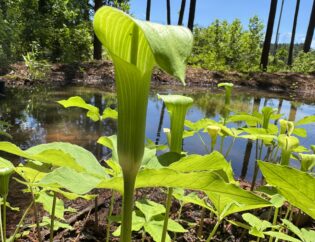 Phlox in the garden: there is a species for every habitat. Do you have dry, well drained soil that bakes in the sun? There’s a phlox for that, actually two: Thrift, Phlox subulata or Trailing Phlox, Phlox nivalis, each of these phloxes creeps along the ground, creating a carpet of tiny narrow leaves. Is your yard inundated with the cool open shade from a canopy of big trees? There are a couple of phloxes for that as well: Garden phlox, Phlox paniculata or Woodland Phlox, Phlox divaricata. Do you have a garden with a part shade to sunny disposition and medium soil? Try some Prairie Phlox, Phlox pilosa, on for size. Phlox flowers are generally fragrant, and often occur in delicate, loose clusters of flowers that range from pale blue, through light pink to brilliant or deep pink. Each of the species listed here is a perennial.
Phlox in the garden: there is a species for every habitat. Do you have dry, well drained soil that bakes in the sun? There’s a phlox for that, actually two: Thrift, Phlox subulata or Trailing Phlox, Phlox nivalis, each of these phloxes creeps along the ground, creating a carpet of tiny narrow leaves. Is your yard inundated with the cool open shade from a canopy of big trees? There are a couple of phloxes for that as well: Garden phlox, Phlox paniculata or Woodland Phlox, Phlox divaricata. Do you have a garden with a part shade to sunny disposition and medium soil? Try some Prairie Phlox, Phlox pilosa, on for size. Phlox flowers are generally fragrant, and often occur in delicate, loose clusters of flowers that range from pale blue, through light pink to brilliant or deep pink. Each of the species listed here is a perennial.
Thrift, Phlox subulata and Trailing Phlox, Phlox nivalis
These guys, they are a couple of “creepers,” but not in the Internet sens e. Their leaves are tiny, spiky, narrow green affairs only about an inch long, if that. They creep along the ground, making a lovely, green spikey mat – that has gorgeous pink flowers in mid to late spring. The bright pink splotches of color in the photo on the right are Thrift, Phlox subulata, planted on an eroded slope in Freedom Park in Atlanta.
e. Their leaves are tiny, spiky, narrow green affairs only about an inch long, if that. They creep along the ground, making a lovely, green spikey mat – that has gorgeous pink flowers in mid to late spring. The bright pink splotches of color in the photo on the right are Thrift, Phlox subulata, planted on an eroded slope in Freedom Park in Atlanta.
Garden Phlox, Phlox paniculata
Phlox paniculata needs open shade, or a “border woodland” type of situation where it will get sun or dappled sun about 5 or 6 hours a day. This species grows to 3 or 4 feet tall, and by fall is topped with short clusters of deep pink flowers. This phlox also wants moist, well drained soil with plenty of organic matter.
Blue Woodland Phlox, Phlox divaricata
This phlox is an early blooming woodland species coming out in March through April to take advantage of the sun peeking between the mostly bare tree branches. The flowers are lovely lavender blue to bluish-pink. Phlox divaricata wants soil enriched with organic material, and part shade to shade. A moist well drained location in your yard would suit it best. This species is rhizomatous, slowly spreading by its roots. Mature colonies make lovely 10-18” tall drifts of blue-lavender blossoms in the shade.
Prairie Phlox, Phlox pilosa
Prairie phlox can take the heat. This plant prefers dry open woods, or  full sun with sandy well drained soil. This is a prairie plant, and it’s tough. Plants that want sandy/rocky soil will need sand added to clay soil. Throw a little finished compost in there as well, but don’t make it too rich (put in too much organic matter.)
full sun with sandy well drained soil. This is a prairie plant, and it’s tough. Plants that want sandy/rocky soil will need sand added to clay soil. Throw a little finished compost in there as well, but don’t make it too rich (put in too much organic matter.)
If all this stuff about pretty flowers isn’t enough, phloxes attract some pretty awesome pollinators as well. These beautiful butterflies and moths use the phlox for nectar: Pipevine Swallowtail (Battus philenor); Achemon sphinx (Eumorpha achemon); Apple sphinx (Sphinx gordius); Slender clearwing (Hemaris gracilis); Hummingbird Clearwing (Hemaris thysbe); Nessus sphinx (Amphion floridensis).
If you’ve never seen a Hummingbird Clearwing or Slender Clearwing moth, oh my! These sphinx moths come out during the day, and from the cornier of your eye, you would think that they were hummingbirds. They move and hover just like their namesake, and the Hummingbird Clearwing is almost the same size as the hummingbird.
So there you have it, a phlox for every season and every habitat will keep you up to your ankles in bright flowers and beautiful butterflies and moths.









